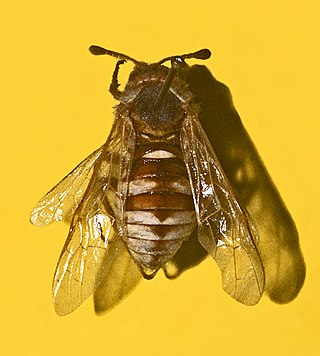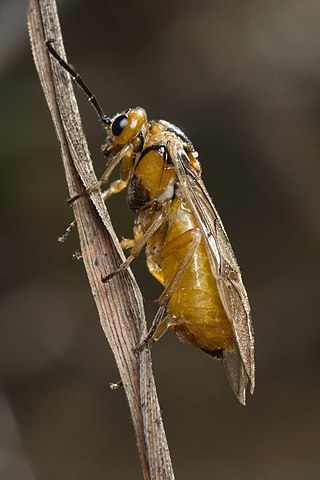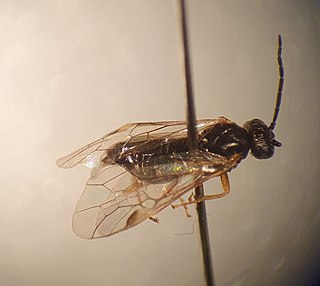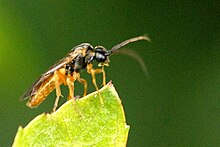
Sawflies are wasp-like insects that are in the suborder Symphyta within the order Hymenoptera, alongside ants, bees, and wasps. The common name comes from the saw-like appearance of the ovipositor, which the females use to cut into the plants where they lay their eggs. The name is associated especially with the Tenthredinoidea, by far the largest superfamily in the suborder, with about 7,000 known species; in the entire suborder, there are 8,000 described species in more than 800 genera. Symphyta is paraphyletic, consisting of several basal groups within the order Hymenoptera, each one rooted inside the previous group, ending with the Apocrita which are not sawflies.

Xiphydriidae are a family of wood wasps that includes around 150 species. They are located all over the world including North and South America, Australia, Europe, and others. Xiphydriidae larvae are wood borers in dead trees or branches of a range of trees. They are characterized as having long and skinny necks with dome-shaped heads. The oldest fossils of the group are from the mid Cretaceous.

The Orussidae or the parasitic wood wasps represent a small family of sawflies ("Symphyta"). Currently, about 93 extant and four fossil species are known. They take a key position in phylogenetic analyses of Hymenoptera, because they form the sister taxon of the megadiverse apocritan wasps, and the common ancestor of Orussidae + Apocrita evolved parasitism for the first time in course of the evolution of the Hymenoptera. They are also the only sawflies with carnivorous larvae.

The Xyelidae are a comparatively species-poor family of sawflies, comprising about 80 extant species in five genera worldwide, and is the only family in the superfamily Xyeloidea. The fossil record of the family is extensive, comprising more than 120 species and including the oldest fossil Hymenoptera species dating back to the Triassic, between 245 and 208 million years ago. Xyelidae are to be regarded as living fossils since they represent one of the oldest lineages of insects and include still extant forms.

The Tenthredinoidea are the dominant superfamily of sawflies within the Symphyta, containing some 8,400 species worldwide, primarily in the family Tenthredinidae. All known larvae are phytophagous, and a number are considered pests.

Tenthredinidae is the largest family of sawflies, with well over 7,500 species worldwide, divided into 430 genera. Larvae are herbivores and typically feed on the foliage of trees and shrubs, with occasional exceptions that are leaf miners, stem borers, or gall makers. The larvae of externally feeding species resemble small caterpillars. As with all hymenopterans, common sawflies undergo complete metamorphosis.

Nematinae is a subfamily of sawflies belonging to the family Tenthredinidae. It contains over 1250 described species in ~40 genera. Members of this subfamily feed on a wide range of plants and employ a wide range of feeding habits, both internally and externally, on their host plants.

Allantinae is a subfamily of sawflies in the family Tenthredinidae, and the largest subfamily of that family, with about 110 genera. The subfamily is considered to consist of five to six tribes, and are medium to large sawflies.

Megalodontes is a genus of sawflies within the Symphyta belonging to the family Megalodontesidae subfamily Megalodontesinae.

Cimbex quadrimaculatus is a species of sawflies in the family Cimbicidae.

Tenthredinini are a tribe of sawflies (Hymenoptera), including the family genus Tenthredo.

Euura is a genus of sawflies of the family Tenthredinidae, subfamily Nematinae. Some of the larvae feed externally on plants and some form plant galls on willows (Salix species). In the case of the gall-forming species, when the female lays her eggs she injects a stimulant and the gall starts to form before the eggs hatch. Most sawfly galls are hard and individual larva tend to inhabit the gall, feeding on the tissue and leave the gall to pupate in the soil. Most of the species are monophages although the type species, Euura mucronata, is polyphagous feeding on over thirty species of willow.

Tenthredo amoena is a sawfly species belonging to the family Tenthredinidae.

Blennocampinae is a subfamily of common sawflies in the family Tenthredinidae. There are more than 100 genera and 600 described species in Blennocampinae.

Monsoma is a genus of common sawflies in the family Tenthredinidae. There are at least two described species in Monsoma.
Fenusa is a genus of common sawflies in the family Tenthredinidae. There are about 11 described species in Fenusa.

Euura proxima is a species of sawfly belonging to the family Tenthredinidae. The larvae feed on the leaves of willows, creating galls. It was described by Jean Guillaume Audinet-Serville in 1823. The species was placed in the genus Euura in 2014 and was previously known as Nematus proximus and Pontania proxima.

Ametastegia is a genus of common sawflies in the family Tenthredinidae. There are about 16 described species in Ametastegia.
Dineura is a genus of sawflies belonging to the family Tenthredinidae.
Adamas is a genus of sawflies belonging to the family Tenthredinidae. It is sometimes referred to in the literature under the name Dinax, but this name is a junior homonym of a name validly published in 1848; claims that the 1848 name was not validly published have been subsequently refuted.




















